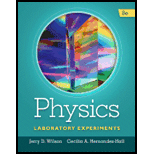
Physics Laboratory Experiments
8th Edition
ISBN: 9781285738567
Author: Jerry D. Wilson, Cecilia A. Hernández-Hall
Publisher: Cengage Learning
expand_more
expand_more
format_list_bulleted
Question
Chapter 4, Problem 3Q
To determine
Whether the air resistance or friction a systematic or a random source of error, and whether it cause the period to be larger or smaller.
Expert Solution & Answer
Want to see the full answer?
Check out a sample textbook solution
Students have asked these similar questions
A
I
squar frame has sides that measure 2.45m when it is at rest.
What is the area of the frame when it moves parellel to one
of
its diagonal with a
m²
speed of 0.86.c as indicated in the figure?
>V.
An astronent travels to a distant star with a speed of 0.44C
relative to Earth. From the austronaut's point of view, the star
is 420 ly from Earth. On the return trip, the astronent travels
speed of 0.76c relative to Earth. What is the distance
covered on the return trip, as measured by the astronant?
your answer in light-years.
with a
Give
ly.
star by spaceship
Sixus is about 9.00 ly from Earth. To preach the star
in
15.04 (ship time), how fast must you travel?
C.
Chapter 4 Solutions
Physics Laboratory Experiments
Ch. 4 - Scientists use models and theories to describe...Ch. 4 - Prob. 2EPCh. 4 - Prob. 3EPCh. 4 - The mass (m) of the pendulum bob may be varied....Ch. 4 - Check with one of your fellow students (or your...Ch. 4 - Describe what is meant by the scientific method...Ch. 4 - What are the physical parameters in the...Ch. 4 - Prob. 3ASACh. 4 - How does the period of a pendulum vary...Ch. 4 - How will you experimentally check the theoretical...
Ch. 4 - Prob. 6ASACh. 4 - How can the parabolic form y = ax2 be plotted as a...Ch. 4 - What is meant by damped harmonic motion, and what...Ch. 4 - It was suggested that you measure the time for...Ch. 4 - Prob. 2QCh. 4 - Prob. 3QCh. 4 - Prob. 4QCh. 4 - Prob. 5QCh. 4 - Suppose in the damped equation had ek1t and ek2t,...Ch. 4 - Prob. 7Q
Knowledge Booster
Similar questions
- (a) For a spherical capacitor with inner radius a and outer radius b, we have the following for the capacitance. ab C = k₂(b- a) 0.0695 m 0.145 m (8.99 × 10º N · m²/c²)( [0.145 m- 0.0695 m × 10-11 F = PF IIarrow_forwardA pendulum bob A (0.5 kg) is given an initialspeed of vA = 4 m/s when the chord ishorizontal. It then hits a stationary block B (1kg) which then slides to a maximum distanced before it stops. Determine the value of d.The coefficient of static friction between theblock and the plane is μk = 0.2. The coefficientof restitution between A and B is e = 0.8.Ans: d=1.0034 marrow_forwardFigure 29-43 Problem 12. ••13 In Fig. 29-44, point P₁ is at distance R = 13.1 cm on the perpendicular bisector of a straight wire of length L = 18.0 cm carrying current i = 58.2 mA. (Note that the wire is not long.) What is the magnitude of the magnetic field at P₁ due to i? P2° R R Larrow_forward
- Checkpoint 1 The figure shows the current i in a single-loop circuit with a battery B and a resistance R (and wires of neg- ligible resistance). (a) Should the emf arrow at B be drawn pointing leftward or rightward? At points a, B C R b, and c, rank (b) the magnitude of the current, (c) the electric potential, and (d) the electric potential energy of the charge carriers, greatest first.arrow_forwardPls help ASAParrow_forwardPls help asaparrow_forward
arrow_back_ios
SEE MORE QUESTIONS
arrow_forward_ios
Recommended textbooks for you
 Classical Dynamics of Particles and SystemsPhysicsISBN:9780534408961Author:Stephen T. Thornton, Jerry B. MarionPublisher:Cengage Learning
Classical Dynamics of Particles and SystemsPhysicsISBN:9780534408961Author:Stephen T. Thornton, Jerry B. MarionPublisher:Cengage Learning University Physics Volume 1PhysicsISBN:9781938168277Author:William Moebs, Samuel J. Ling, Jeff SannyPublisher:OpenStax - Rice University
University Physics Volume 1PhysicsISBN:9781938168277Author:William Moebs, Samuel J. Ling, Jeff SannyPublisher:OpenStax - Rice University Principles of Physics: A Calculus-Based TextPhysicsISBN:9781133104261Author:Raymond A. Serway, John W. JewettPublisher:Cengage Learning
Principles of Physics: A Calculus-Based TextPhysicsISBN:9781133104261Author:Raymond A. Serway, John W. JewettPublisher:Cengage Learning Physics for Scientists and Engineers: Foundations...PhysicsISBN:9781133939146Author:Katz, Debora M.Publisher:Cengage Learning
Physics for Scientists and Engineers: Foundations...PhysicsISBN:9781133939146Author:Katz, Debora M.Publisher:Cengage Learning Glencoe Physics: Principles and Problems, Student...PhysicsISBN:9780078807213Author:Paul W. ZitzewitzPublisher:Glencoe/McGraw-Hill
Glencoe Physics: Principles and Problems, Student...PhysicsISBN:9780078807213Author:Paul W. ZitzewitzPublisher:Glencoe/McGraw-Hill Modern PhysicsPhysicsISBN:9781111794378Author:Raymond A. Serway, Clement J. Moses, Curt A. MoyerPublisher:Cengage Learning
Modern PhysicsPhysicsISBN:9781111794378Author:Raymond A. Serway, Clement J. Moses, Curt A. MoyerPublisher:Cengage Learning

Classical Dynamics of Particles and Systems
Physics
ISBN:9780534408961
Author:Stephen T. Thornton, Jerry B. Marion
Publisher:Cengage Learning

University Physics Volume 1
Physics
ISBN:9781938168277
Author:William Moebs, Samuel J. Ling, Jeff Sanny
Publisher:OpenStax - Rice University

Principles of Physics: A Calculus-Based Text
Physics
ISBN:9781133104261
Author:Raymond A. Serway, John W. Jewett
Publisher:Cengage Learning

Physics for Scientists and Engineers: Foundations...
Physics
ISBN:9781133939146
Author:Katz, Debora M.
Publisher:Cengage Learning

Glencoe Physics: Principles and Problems, Student...
Physics
ISBN:9780078807213
Author:Paul W. Zitzewitz
Publisher:Glencoe/McGraw-Hill

Modern Physics
Physics
ISBN:9781111794378
Author:Raymond A. Serway, Clement J. Moses, Curt A. Moyer
Publisher:Cengage Learning